This site contains affiliate links. As an Amazon Associate, I earn a commission from qualifying purchases at no extra cost to you. Full Disclosure Here.
Most everyone uses laundry detergent and if we’ve kept a record of the cost, at the end of the year we would be surprised at the expense for that one product alone. If we are counting our pennies, and who isn’t, it might be economical to learn more about homemade household cleaning products, specifically laundry detergent. It can be made for pennies on the dollar compared to the popular commercial brands.
The great thing is that homemade cleaning products work as well or better than the more costly products purchased from the store.
Another benefit is that our homemade versions do not have added fillers which often cause breakdown in the fiber of our clothing or cause fading and chemical residue. Here is some information to consider.
Laundry Detergent Fillers
Fillers are usually chemicals that have been added to laundry detergent to be used as a binding agent for water and to add bulk to the bottle or box of detergent, therefore making you think you are getting a better deal at the grocery store. Filler’s can count for up to 45% of your laundry detergent! Bigger is not always better!
Those fillers are there to make it appear that you are getting more for your money. It is one way for manufacturers to charge more, while you, the consumer, are getting an inferior product.
Some detergent brands may be increasing your family’s risk of asthma, skin irritation, hormone disruption, and cancer. It’s important to remember that your exposure to the toxins in your laundry soap don’t stop when the clothing is folded and put away. Some of these products are engineered to remain on and in your washed items – this is evidenced by the “fresh scent that lasts and lasts”.
I saw an ad recently that claimed that the fresh scent would last for many weeks. This is particularly true of the added wax-like scented beads which are put into the wash cycle. I know, they do smell good but instead of using those chemical filled, expensive products, I have found that adding a few drops of a favorite essential oil to a woolen drier ball works very well and smells great, with no added negative side-effects; it just doesn’t last as long.
So in addition, I often add a few drops of an essential oil to a few small pieces of felt then put them in the dresser drawer. Lavender, rose, jasmine and lemon are all nice but you can choose from the many options available in the essential oil world. There are many brand and scent options.
A few common fillers in your detergent are:
- 1,4 DIOXANE- a synthetic oil-based carcinogen
- GLUTEN- wheat and other grains are used to thicken and extend products
- ALCOHOL- decreases the detergents freezing point and increases solubility
- LIMESTONE & CHALK- Calcium based to work with phosphates in increase suds
- PERFUME & COLOR- Covers the smell of chemicals and makes it look “pretty”
- SODIUM SULFATE
Facts about Fillers
- Fillers are often made of sodium sulfate. To discover if your laundry powder contains sodium sulfate you can do a simple test. Put one teaspoon of laundry powder into a cup of water and stir. Sodium sulfate will not dissolve and can be clearly seen at the bottom of the glass. Some fillers are ground down into a very fine sand-like consistency, making them more difficult or impossible to detect.
- They get into the fibers of your clothes and grind together (with washing ) therefore they lessen the life of your clothes and make them look faded and pilled.
- After just 10 washes, clothes, towels and blankets gain 2% of their weight in detergent residue (fillers and chemicals) and are constantly being absorbed by the skin.
Save big by using “clean” detergent! I did a little poking around and found that washing machine repairmen are very aware that these fillers are causing more frequent machine breakdown. Our own repairman was very open about the subject and the shortened life span of machines due to additives and fillers in detergents.
With the cost of a washer ranging between $350. to over $1000., who can afford to replace a washing machine more often than necessary? Taking better care of your machine can give you savings that then can be used to purchase some of those special preps you’ve been wanting.
One of the main reasons we switched to making DIY laundry powder was because our youngest child had sensitive skin and would sometimes develop a rash and redness where clothes touched the skin. This reaction happened even when we switched to detergents that were touted as being mild and suitable even for babies.
We found that the two “mildest” brands caused even more skin reactions and this happened even if I ran the clothes through a double rinse cycle. It took me a while at that time to find the right detergent “recipe” that worked for her sensitive skin.
Yet another negative effect is that fillers can trap bacteria in your clothes, causing smelly, sweaty clothes to quickly smell bad again soon after washing.
Here is a website that gives grades from “A” to “F” to specific detergents and other cleaning products that you may find interesting.
People often ask if this detergent can be used in High Efficiency (HE) washing machines. Yes, it can. The first time you use this Zote recipe you may question if it is effective because it makes very few suds, if any. Rest assured that if you can get over the idea that seeing suds means cleaner clothes you will see the results and be pleased.
Recipe: Zote Powdered Laundry Detergent Recipe
2 14 oz. bars of ZOTE soap. Some folks use Fels Naphtha soap but in doing that you must consider that the Zote soap bar is about 15 oz. and the Fels Naphtha is only 5 oz. per bar. So Zote is more economical to use. There is a concern with Fels Naphtha because it contains titanium dioxide which some say is bad for septic tanks and toxic to our waterways.
I have not researched this down to the chemical level but since we do have septic I have chosen not to use it. I like the smell of Zote better anyway. Some folks use Ivory soap. You choose. The next time I make laundry detergent, I am going to use Dr. Bonner’s soap bars. They are a bit more costly but without any colorings.
1 box 20 Mule Team Borax. Borax is a naturally occurring mineral that is great for whitening and deodorizing. One of the most popular kinds of borax is made by 20 Mule Team and usually comes in 76 oz. boxes. (Wal-Mart and larger grocery markets)
Let me share some information about an ongoing confusion as to what 20 Mule Team Borax is made of and if it is safe to use as a laundry product. Borax is sodium tetraborate or sodium borate. It is not boric acid (hydrogen borate), which seems to be a misconception that’s going around the web and has caused concern about using Borax for cleaning purposes.
Borax is a salt of boric acid but it is not chemically the same as boric acid. Like many other natural substances sodium tetraborate should not be ingested nor come into contact with your eyes, nor should it be applied directly to the skin. Other than that I can find no cause for alarm and no reason to fear borax when used externally in laundry soaps or cleaning supplies.
The safety studies that I could find were related to either ingesting borax, or keeping it out of your eyes. 20 Mule Team Borax is considered pure boron, a natural element. It is considered non-toxic to humans even though it is toxic to insects.
1 box Super Washing Soda– 55 ounce size box – This is a household cleaner and laundry booster and is made by Arm & Hammer. It helps to neutralize laundry odors. This is not baking soda. It can be found near the 20 Mule Team Borax. Washing soda or soda ash; is a white powder that is used to remove dirt and odors. (Walmart and larger grocery markets)
3+ cups Baking Soda. If you have hard water this will soften it and it helps eliminate odors as well. Even though you may need only 3 cups of this larger box there are so many other household uses that using this natural cleaner, deodorizer, and personal care product, will not go to waste. I always keep at least one large box on hand. (Walmart sells the larger size box which is more cost effective than buying the smaller one pound boxes from the grocery store.)
2—16 oz. or 1– 32 oz. containers Awesome Oxygen base cleaner. Sometimes they have Awesome Oxygen Orange in a 32 oz. container, orange label and that is the better buy. They always have the 16 Oz. jar with blue label. Either is fine. (Dollar Tree) You may also use brand name Oxyclean but that can be a bit pricy. Awesome Oxygen from the Dollar Tree does the same job and is less costly
Instructions:
Finely grate the Zote soap bars. Hand grate on smallest size grate to help it dry more quickly. Spread out on cookie sheets and allow to dry for 2 days.
This step takes a little patience. It’s a good idea to wear a mask while grating the soap because it has a strong scent.
(Drying makes blending with other ingredients easier. After drying put the grated soap into a food processor in small batches, wearing a mask.)
In a very large pot or 3 gallon container begin layering all of the ingredients. Again wear a mask as the fumes and dust can be strong. When all is mixed thoroughly put into a lidded container, either plastic or glass. Use a 2 Tbsp. scoop that comes in the AWESOME Oxygen container as your measuring scoop. If you are washing a small washer-load of clothes use only one tablespoon.
You may add a scent like Unstoppables but it is not a softener and adds expense and chemicals to the detergent. I would not use Unstoppables or any added scents if this laundry detergent is to be used on clothes for babies or young children or with people who have skin allergies. As with any new product you try, be alert to any sensitivity your family might have when changing to new products.
We have not had any problems and have been using Zote based laundry detergent for about six years, but we don’t add the various chemical scents. Usually I add a few drops of natural essential oils like lavender, lemon or sandalwood to woolen dryer balls. In addition to making the laundry smell wonderful, the laundry room smells heavenly as well.
To further reduce the cost of laundry you can use crumpled up balls of aluminum foil in place of chemical laden drier sheets. These can be used over again several times. I’m always glad for more savings.
If you try this laundry detergent recipe and want to store enough of the individual ingredients for the next year’s batch, I have a few suggestions, gleaned from sad experience. Any powdered product stored in cardboard can absorb moisture fairly quickly causing the contents to clump and even turn into a solid mass, especially if the box has begun to split a bit at the seam….(see photo below)
I know I could probably hit this Washing Soda clump with a hammer and put them into the food processor or blender but it’s so hard packed that I’m not sure this would be a wise thing to do. Using a serrated spatula to scrape the block into a large container seems to work, but it isn’t something I want to repeat any time soon, even if my dear husband is willing to help. Hopefully this will be the first and last time this challenge arises!
As soon as the boxes of Borax and Washing Soda are purchased I will put them into larger canning jars with lids along with a clay desiccant packet or oxypacks. Another way to keep the powders away from moisture would be to seal the inner part of a two piece canning lid using a Food Saver Jar Sealer. That process takes about 10 seconds.
Another option would be to place the unopened box into a plastic bag to protect from moisture. This only needs to happen if you are storing these ingredients over the period of 6 months to a year. Just give them a check now and then.
LA’s Totally Awesome Oxygen. This stuff is also great for spot cleaning carpets. It does a good job on grout and tile after making a thick paste, applying it to area and allowing it to stay there for about 5 to 10 minutes before washing it off with a wet cloth.
Put the dried, grated soap into the food processor in batches. If you opt not to do the drying process you take the chance of ending up with a sticky substance that will not blend well with the other dry ingredients, so take the time to air dry the grated soap bars to assure an even blending of all ingredients.
The Zote soap that has been grated, dried, and then run through the food processor condenses down to about 4 cups of concentrated powder. This is two large bars. Surprisingly this pure soap “powder” melts in cold, medium and hot water with just a little agitation. Remember there are little, if any, suds. Don’t let that fool you. This is a powerful cleaner.
Next, collect all ingredients and put on a surgical type mask. Into a large container, like this 3 gallon bucket, pour all five powders and blend well and evenly.
 |
 |
 |
 |
Using a sturdy spoon blend all ingredients until evenly dispersed. If you don’t use a mask the concentrated dust from the grated soap and the Borax dust that billows into the air will get into your lungs, so don’t take the mask lightly.
Final Thoughts
Finished product: About a year’s worth of laundry detergent for $12.50! We are now a family of two so you can extrapolate your own family’s approximate needs based on that calculation. This will do approximately 225 loads of laundry using 2 tablespoons per load.
For extra-large or heavily soiled laundry you could use up to four tablespoons. The plastic scoop that comes in the LA Awesome Oxygen cleaner container is exactly two tablespoons.
There are no fillers or harmful substances in this detergent so a little goes a long way. Of course, there are still sensitivities to detergents so be alert when you begin using a new product. Avoid getting into your eyes or having direct contact to your skin in concentrated form.
One question that might be on your mind is, ”Can I make liquid laundry detergent?” You sure can. The reasons I choose to make the powdered soap are simple. First, to make the same amount (enough to wash 225 loads of laundry) and using this very exact recipe, if converted into a liquid form it would equal 10 gallons! That would take up a lot of my laundry room space.
Second, the liquid version settles and clumps a little so must be shaken up or stirred if left sitting for long.
Third, what containers should you use to store the liquid version in? One might think that clean plastic gallon milk jugs would do the job. There are two drawbacks with this choice. The milk sugars cannot be completely cleansed from the plastic, so there is a possibility of contamination. The other reason is that the plastic jugs are likely to breakdown and disintegrate.
I don’t want 10 gallons of liquid laundry detergent oozing all over the floor! (This breakdown of milk bottles happened to a friend and she was only storing water!) If you have high mil, clean plastic containers in mind and you have the space then go for it and store 10 gallons.
You can choose to use two five gallon heavy plastic buckets. They are difficult to move when full and still must be stirred every once in a while, so you’ll need a long stirring stick or agitator. I have a friend who chose this route last year and she’s quite happy in her choice.
What I have given you in this post is one recipe and one way to cut laundry costs that I have found effective and, of course, economical. There are variations and substitutions which can be used. I’d love to hear the experiences and tweaks you may have used for your laundry needs. If you have not tried to make your own laundry soap I hope you’ll put this one to the test.
Blessings, Donna
If you enjoyed this article, consider following our Facebook page.


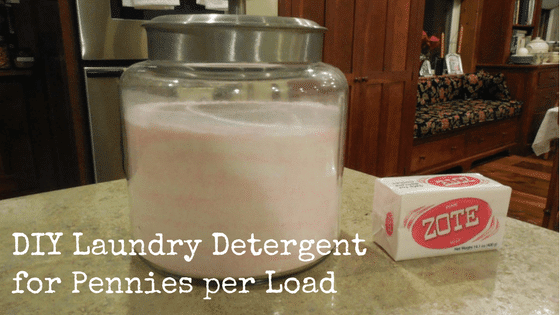

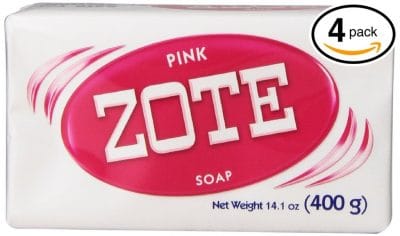



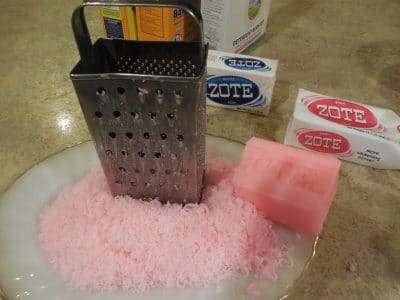

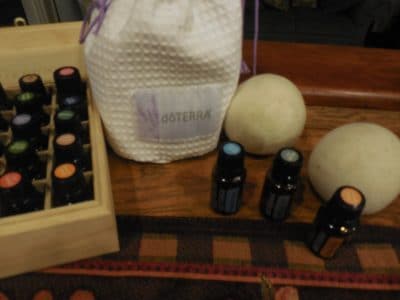

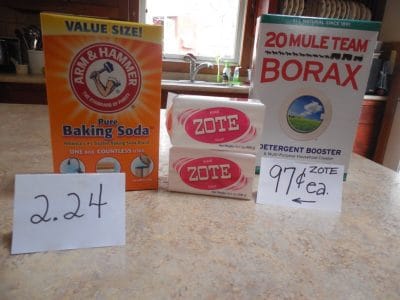
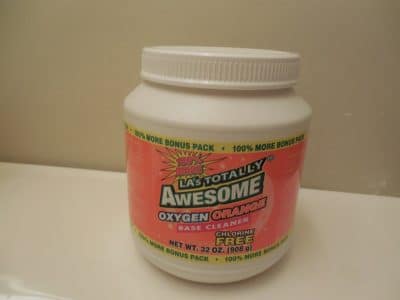

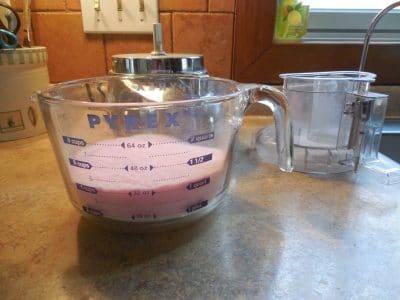
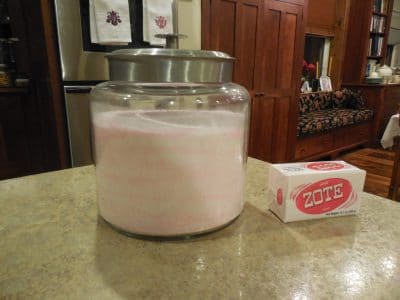
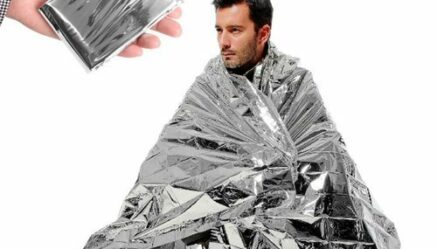





117 Responses to “DIY Laundry Detergent for Pennies per Load”
I am very late commenting, but would like to add that I have discovered that 1 tablespoon of liquid Tide works well even in a top loading washer. And on my husband’s VERY dirty work clothes. I put it in a pump bottle and know how many pumps to use. It still wouldn’t be as economical as making your own, but makes a bottle last a very, very long time.
I am looking very forward to trying this recipe. I have previously made the kind in a 5 gallon bucket—didn’t like having to stir it each time or take up all that space with the bucket.
Good to know about the American made Sun products. I usually feel guilty about buying at Dollar Tree because of everything coming from China.
Another tip: Wet a Fels naptha bar and rub it on poison oak. I am VERY allergic and this is the most effective treatment yet!!! And CHEAP!!! Do it several times throughout the day if you have blisters. I’m also sure it would be as good as the expensive products about stripping the oils off your body if you suspect you have had contact.
You are so right about using a much smaller amount of commercial laundry detergent than the manufacturer’s recommendation. Since starting my tests, I have also used cold water exclusively and logic notwithstanding, see no difference at all.
Hi! Jumping in 🙂 Thanks for the recipie, Ive been looking around alot and finally found one I think I might try 🙂 As a Mom of 4, I love the no muss no fuss idea 🙂
As far as the water temops, I have NEVER used anything but cold water…hot isnt even hooked up to my washer! LOL!
If I have access to store bought products like Dawn, why not just buy laundry soap?
Cost plus store-ability. Borax and washing soda are also store bought products. The difference is that a box of each plus a small bottle of dishwashing soap will make enough laundry detergent for thousands of loads of laundry. The cost will only be a penny or two per load.
Also, storing a box of borax, a box of washing soda and a bottle of Dawn (or other dishwashing soap) takes up very little space.
Never mind about the dingy whites – I found the reply. But still wondering whether a cheap dw would work as well as Dawn. Probably not, as it doesn’t work as well for dishes!
Oops, I found this reply, too. I swear they weren’t there the first time I looked. Anyway, I am definitely going to try with the Dawn. It only takes 2 tablespoons so a bottle would last a long time. Thanks.
Dawn (or some stores house-label equivalents) is a very good product because of its grease / oil removing capability and relative safety of use. Animal rescue organizations use Dawn to remove oil from contamination events like the BP Deepwater Horizon disaster in the Gulf of Mexico that gets on migratory birds, they can wash the bird directly with it and the bird does just fine.
Paul – Do you happen to know of some good, store brand, equivalents? OTOH, Costco has frequent coupon sales on Dawn as do many grocery stores.
I’m sorry – I lost your reply to my question about dingy whites. Also, whether a cheap dishwashing liquid would work as well, or should I stick with Dawn? Thanks!
And those dryer sheets get bug stuff from your car bumpers, and clean dried bug guts from your windows real well.
I must tell you about Sun products, made in USA, and Bowling Green is one producer here near my home.
I needed a whitener and I do NOT like bleach.
At the Dollar Tree and many dollar stores these products are on the shelfs.
I put this in with my whites only one day and was amazed at the whitening ability.
So, now I mix it in with my two crystals A & H, and Borax.
Try it..non-chlorine, color safe…looks like this. 19 oz. for $1.
//www.dollartree.com/Classic-Sun-Detergent-With-Color-Safe-Bleach/p22996/index.pro
Oh I LOVE Dollar Tree. Next time I am in the city I will pick some up. I have seen the SUN products on the shelves but passed it by thinking is was just too cheap to be good. My bad. Thanks for the tip!
Gaye
This has got to be the easiest homemade detergent recipe I’ve seen. I’ve been collecting homemade detergent recipes for a while but did not want to have grate bar so and cook up a batch. And, I like Dawn dishwashing liquid-I think it really helped my homemade dishwasher detergent. I like Dr Bronner’s for other stuff but for cleaning, nothing beats Dawn. It just works so I need to add some to the stockpile. Thanks for sharing your recipe.
I do not have a utility room – just a closet with a smallish, stackable washer dryer. I like that I can make up a small batch and not worry about storage.
I have not tried DIY dishwasher liquid yet.
I put the vinegar in a Downey Ball, and throw it in at the beginning of the wash cycle. I do make my laundry detergent with Fels; I’ve simplified the recipe greatly. The reason I use Fels is because I can get a lot of bars in a very small space. Dish soap if fine to use, but I wouldn’t count on having it around for a long time in an extended emergency situation. You can place the bars in individual vacuum bags or zip bags and press the air out. Place them in a used plastic cat litter box and press down the lid. I have printed out the recipes for various kinds of homemade soaps and cleaners, and I keep them in a binder.
Karen – so many of the DIY Laundry Detergent recipes are a mess to deal with. I am sure my readers would be interested in a simplified version that can be made in small batches.
— Gaye
Gaye-Here is my scaled-down, easier recipe:
1 bar of Fels-Naptha soap, grated
1 cup washing soda
1 cup borax powder
3 tablespoons essential oil (optional)
1 five gallon bucket
5 (one gallon) recycled vinegar or other jugs
Grate soap into 1 gallon of water in an old non-aluminum pot or bucket you’ve set aside just for making soap. A regular 2 gallon bucket with a lip is good for this. Stir in the washing soda, the borax, and choice of essential oil, if using. Then use an immersion blender to blend completely. Pour into a five gallon bucket. Add hot water to equal five gallons, rinsing the pot or bucket with some of the water and pouring back into the bucket. Stir well, then allow to sit, covered, for 24 hours; it will gel up and look like egg whites. Blend again if necessary and decant into 5 one-gallon vinegar jugs (set them in the sink, and use a funnel to fill). If needed, shake before each use.
Using 1/2 cup for each load, this recipe will make about 160 loads.
I keep a 1/2 cup measure sitting upside down on the jug I’m currently using.
Vinegar jugs are best for this application, as they are made to stand up to corrosive stuff. I found out the hard way that milk jugs are only made for milk.
This recipe can be cut down to make just the amount of laundry soap you would like.
This is the recipe I use too. As to vinegar, add to last rinse as you would fabric softener. The vinegar works any remaining soap out, so no fabric softener is needed unless you want it. Hadn’t thought of the vinegar jugs…we use those detergent containers which can sit on the shelf and has a spigot. We use less too. I’m currently experimenting with Ivory bar soap for the gentle fabrics. will let you know.
I have found that opening the bars of soap and letting them dry out before using makes them way easier to grate… in fact no problem at all.
Also, when I got a new washer/dryer stacking combo, it is the HE kind and they recommended the laundry detergent be put in first. The ONLY way it works for me!
I was in the hospital and an acquintance “helped” with my load of laundry. Needless to say, she did not read instructions and I had to rewash the whole load.
Thanks for this info…one of the best posts I’ve read on home made laundry detergent. I do have a question. I recently started line drying clothes outside. Prior to that, I had used a fabric softener sheet (actually half a sheet to save money) in the dryer. My washer is old enough that it doesn’t have a fabric softener dispenser. Could you tell me the mechanics of using vinegar…mainly when do you put it in the washer? It would be great if you could put it in right away rather than having to come back at some point during the cycle. Thanks again for all your info…I enjoy and appreciate your posts.
My washer has a dispenser so during my trial, I put the vinegar in there. I think the best thing for you to do is to add it with your laundry detergent at the beginning of the cycle and see what happens.
The other thing is that there are some recipes on the internet for re-usable “homemade dryer sheets” made from scraps of flannel or other cloth. You might want to do some research and see if that works for you. (Maybe I should give it a try too – so that I can share the results :))
I have read that vinegar will neutralize the soap (acid reacting with alkaline detergent). If you don’t have a dispenser, use a Downey ball or the like.
Put in with the rinse cycle or ur wasting ur vinegar.
Hey – the reason that the store bought “soaps” don’t work for laundry is that the superfat (loose fats left over after saponification :the act of mixing the lye with the fats) is way too high. When you make a laundry soap at home – the bar kind – you do not leave any free-floating fats out there. That’s why the Dawn works well. Because it cuts grease because there are no added fats. For you that make soaps at home – go ahead and make bar soaps, but at 0-1% only of superfat. You will be so happy with the results. The store bought stuff is meant to be good for skin, not for laundry. Laundry soap made with the Dawn is very good. I’ve made them all – but I do not purchase store bought soaps at all – it’s just a waste of dollars all the way around. I have had to use my clothes washing system this year with the plunger washer and buckets. I used the Dawn laundry detergent because it was fast and I had wet laundry everywhere – So either use the Dawn or make your own at 1% or less superfat – You’ll be very happy with the results.
How do you feel about bars of Fels-Naphtha and Zote? I know they are popular but for me, using Dawn was so much simpler and very effective.
Hi – I have made the powdered version with Fels Naptha, Borax and Washing Soda. I also put in some Oxygen powder like OxyClean. I added liquid bleach with my white loads. After awhile my whites got dingy and gray. We do have a water softener, by the way. What could be causing the dinginess? My husband wants me to go back to
Tide because his t-shirts look so bad. RE the vinegar – I put it in a Downy Ball and it does a good job of softening. Thanks, Jan
Jan,
I have always used bleach with my whites but gave it up for this test. My laundry area is in a closet and there is a carpet in front of it. I have always worried the beach will splatter and spot my carpet. On laundry day I lay out broken down cardboard boxes in front of the washer – just in case. Since using my DIY laundry detergent, I have not used bleach at all and am happy with the results – and this is using cold water. I am so pleased.
Anyway, my guess is that the borax is not completely dissolving and interacting with the salts and minerals in your water. I think a water softener still leaves some minerals but not 100% sure. Will Tide turn the dingy tee shirts white again or are they now toast? The reason I say that is it would be worthwhile to get them white again then go back to a DIY laundry detergent with no additives (bleach, oxyclean) just to try to isolate the problem. And for sure, I would try this liquid version since you know that the borax is dissolved.
The alternative is to use 1/2 the recommended amount of TIDE and cold water and at least save some money that way.
— Gaye
I had the same problem. It took about 8 months before we were sure it was the detergent. At first, I thought it was the fabric softener. But the buildup was all inside my washer and hubbies shirts. Gray grim!! Switching to the dawn detergent was a life saver. We noticed and immediate difference!! Now, I use that and mix vinegar and fabric softener for the rinse. Clothes are great! And I do a lot of laundry, we have 6 in this house!!!
Does it need to be Dawn, or would the cheaper ones, like from the Dollar Stores, work as well?
I would try making up a small batch and see how it works. I have some Costco brand dish soap in my garage – I should try it and compare it to Dawn. For dishes, I prefer the Dawn since I can use a lot less to get the job done.
It does go on sale a lot. Costco usually has $3 off coupons and I see ads for it all the time.
I started by using Dawn, but now I am using Gain dish soap. It smells nice. I also added 1 extra tbsp of every ingredient in my last batch, just because I found one site where they adjusted their ingredients the same way. My kids run a lot and their clothes get very sweaty, and my husband works in a factory. I think the dish soap recipe works much better than the recipes w/the grated soap. I had no luck w/those, especially the cooked version–our clothes always stunk, and whites got very dingy.
I may actually continue to use my regular detergent for whites, but am hoping I will continue to be pleased with this new recipe for all of my other loads. I have a front loader, and everything I washed today came out fresh and clean.
I am going to try adding the extra tbsp. in my next batch. I don’t really have a problem now but every once in awhile, a spot will remain on my whites.
As far as the DIY laundry soap with grated soap/Fels Naptha? That did not work well for me at all. Even the darks seemed dingy after using it and the finished load had an odd smell. I did not think that the bar of Fels rubbed over a stain did much to remove the stain either.
I have having modest luck with hydrogen peroxide as a spot remover.
I had the same problems you did with the liquid Fels Naptha soap. In fact, sometimes a whole load of laundry would come out of my dryer smelling like perspiration odor. I never have/haf that problem even if I use a cheap store-bought laundry detergent.
Try using liquid dish soap on stains or pretreat them with a 50/50 white vinegar and water spray. Both seem to help. Again, I am worried about whites getting dingy so I am sticking with regular detergent for those. I hope this homemade detergent doesn’t fade my darks either. I may use less per load or make up a weaker batch for darks.
So far my darks are fine – actually better than with the commercial laundry soap. My guess is that the store-bought leaves a residue. We have water on the soft side so I don’t use a vinegar rinse very often although when I first started with the DIY, I used vinegar in the fabric softener dispenser and I think that brightened up my darks.
Or it was my imagination LOL.
I use the Aldi brand of dawn and it works great.